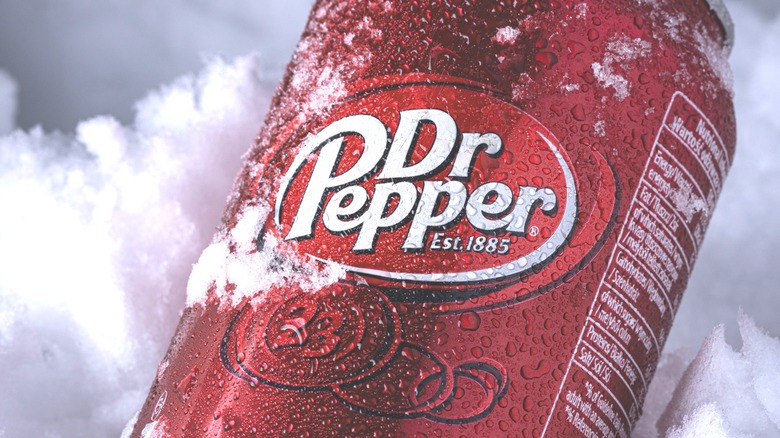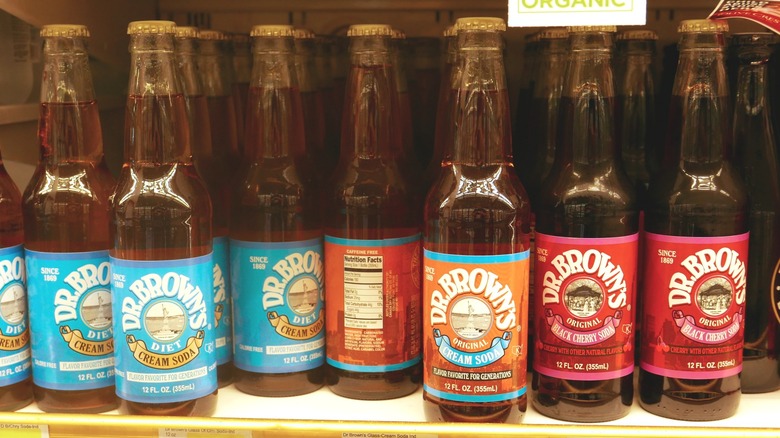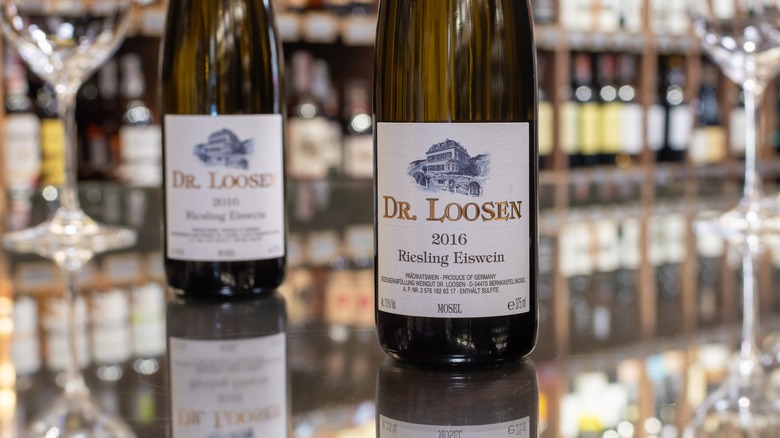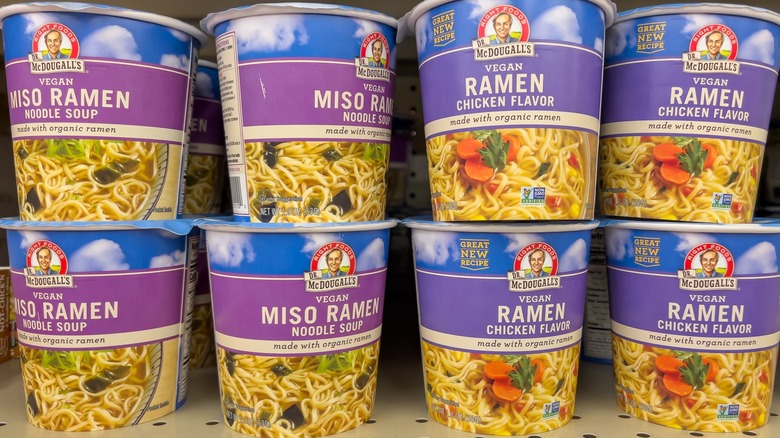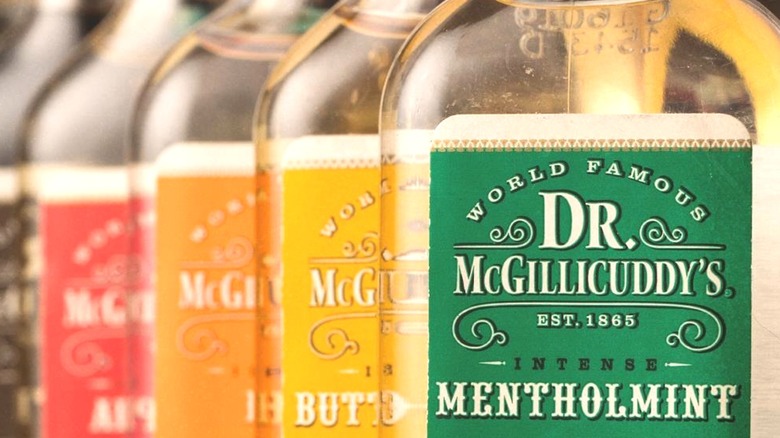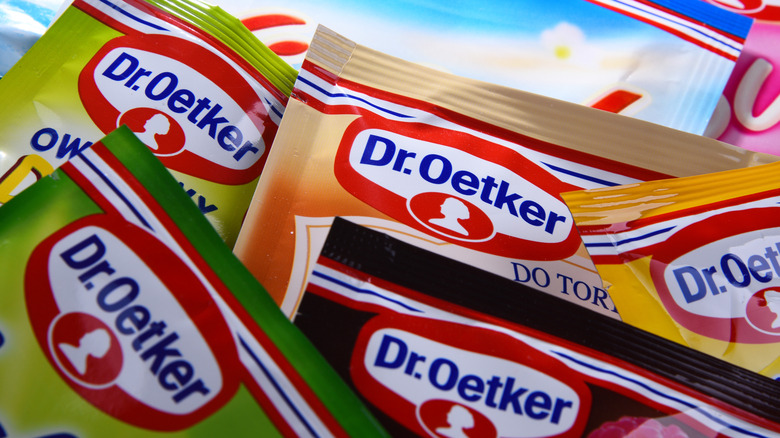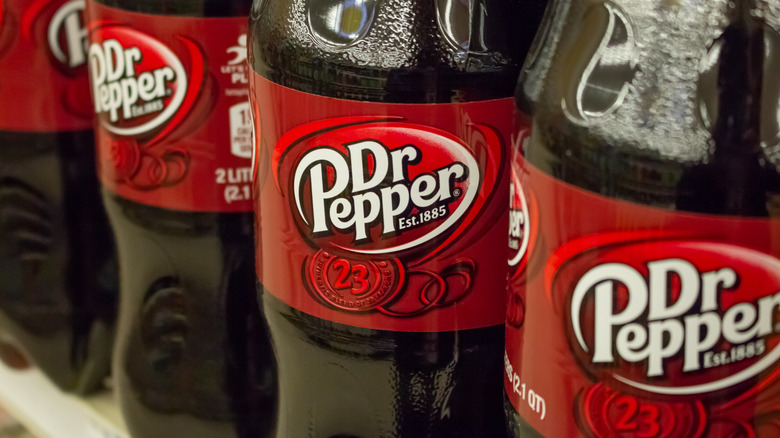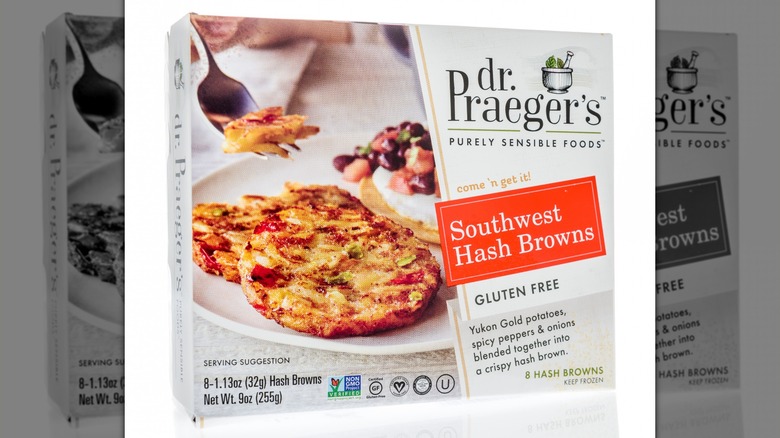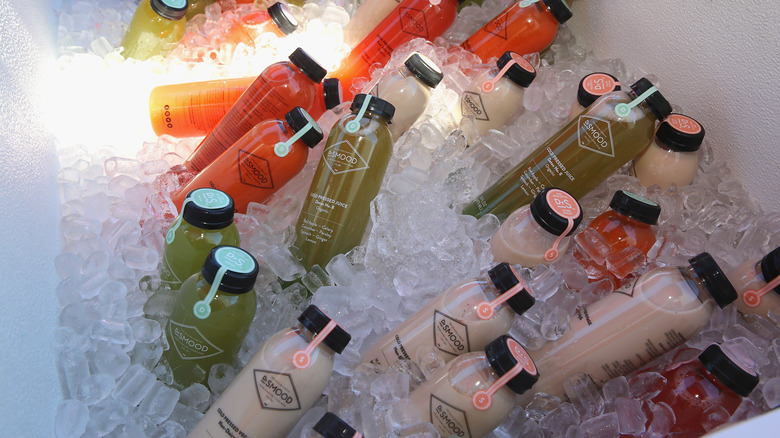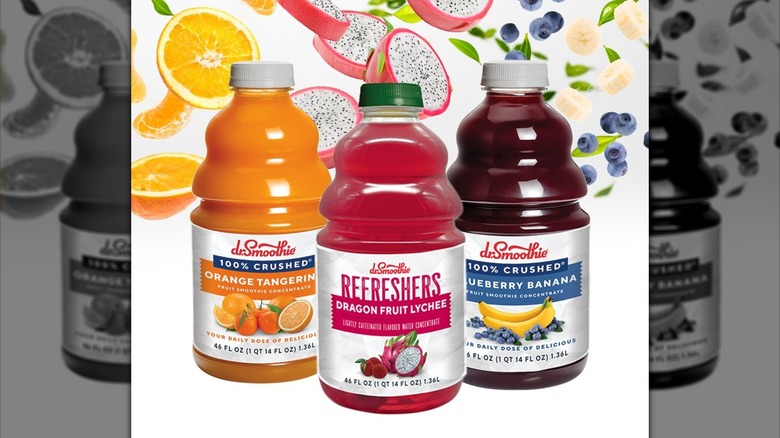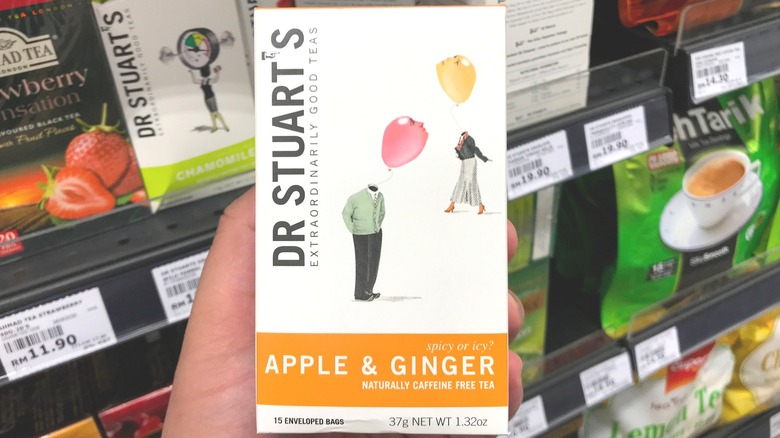10 Foods And Drinks That Have Dr. In The Name
During the mid-19th century, patent medicine appeared on the scene and promised miracle cure-alls in the form of syrups, elixirs, tonics, liniments, and the like. These "medicines" had grandiose names to attract leery buyers. To sound more legitimate, authoritative, and of sound science, many fronted the name of a good doctor, a Dr. Feelgood if you will, even if there was no actual doctor behind these nostrums.
When greater oversight, enhanced standards, and transparency in composition and ingredients took hold in the 20th century, these faux-remedies began to fall by the wayside. However, products continued to be sold using a good doctor's name, real or unreal.
While the list is not endless, there are some food and drink brands that still include this moniker in the name. Let's examine 10 of these product lines to see if an actual resident "Dr." was ever in on it or if it was all just a part of sneaky marketing.
1. Dr. Brown's
When it comes to ordering drinks at a Jewish delicatessen, there is only one name that truly matters — Dr. Brown's. Sadly, there is no officially known origin story of Dr. Brown, or even what his first name was. The brand's marketing director, Harry Gold, told the Los Angeles Times in 1986, "We have no records that tell us anything about the good doctor. It's like a biblical story. We accept it on faith." Novelist Bernard Cooper even wrote an ode to Dr. Brown's in the New York Times, likening the mythical figure "as a kindly, white-coated man not unlike my dentist... In a pristine laboratory filled with bubbling test tubes and beakers."
Dr. Brown's first made a name for itself in the endless delis across New York with its celery seed-extracted Cel-Ray Tonic before hitting store shelves. It would be followed by other hits like Cream Soda, Ginger Ale, Black Cherry, and Root Beer. The brand's labels, which feature images of iconic New York landmarks, were designed by Herb Lubalin .
2. Dr. Loosen
After World War II, the quality and demand for German wine declined, and the same could be said for the Loosen (pronounced loh-zen) family vineyards in the rich Mosel Valley region. That all changed when Ernst Loosen gave up the idea of being an archaeologist, saved the almost 200-year-old estate from being sold outside of the family, and became a revolutionary vinter in 1988. Loosen named his line Dr. Loosen in memory of his father, who earned the title in the study of law, and to breathe new life into the dry Riesling winemaking his grandfather had nurtured.
While Loosen's unorthodox methodology compelled the staff he inherited to immediately quit, he proved rather quickly to be quite adept at winemaking. He preached the gospel of Rieslings and in practice put them back on the map. He has since won a slew of awards like Winery of the Year, Man of the Year, and was even noted as one of the World's 50 Most Influential Winemakers. Loosen has collaborated with U.S. winemakers Chateau St. Michelle and J. Christopher and played on his own brand's name with sub-labels Dr. L and Dr. Lo, which is a non-alcoholic wine.
3. Dr. McDougall's Right Foods
After years of research and practice, internist Dr. John McDougall found a pioneering path to a healthy life through a plant-based diet. Refraining from meats and putting an emphasis on starches like whole grains, rice, pasta, fruits, and vegetables, he created the McDougall Program for others to follow in his footsteps.
Dr. McDougall's Right Foods launched in 1993 and was co-founded with Jim Ahrens, who was a graduate of the McDougall Program and later befriended the doctor. Initially, the low-fat, low-cholesterol, vegetarian line consisted of instant meals in a cup, which McDougall and his family tested, and signed off on. While some have questioned why a doctor would get into the retail business, Dr. McDougall saw it as a way to advertise his methodology and offer better food options than larger conglomerates. A cartoon version of Dr. McDougall's smiling face continues to invite customers to buy cups and boxes of his ramen, soups, and Asian noodles.
4. Dr. McGillicuddy's
When Seagrams introduced its schnapps line Dr. McGillicuddy's in 1984, it created a whole backstory for the doctor to give it a bit of old-fashioned history. The story goes that Dr. Aloysius Percival McGillicuddy left his world-famous Mentholmint schnapps recipe to the world in his last will and testament. Designer Steven Noble was hired to flesh out the look Dr. McGillicuddy as a proper-looking gentleman to help reinforce the legend.
The good doctor's spirits were acquired by Sazerac Co. in 1989, and nine years later, Dr. McGillicuddy's owners convinced a North Dakota town to rename itself in his honor. In 1998, Granville beat our other towns for the right to be called McGillicuddy City for four years and earned $100,000 for doing so. The town drank up its claim to fame and celebrated its 25th anniversary as McGillicuddy City in the summer of 2023. Business also got into the spirit: The Branding Iron Saloon became the Shady Eye Saloon, and the community center adopted the doctor's surname.
Today, Dr. McGillicuddy's serves up 10 flavors. You can get your hands on Butterscotch, Coffee, and Apple Pie, as well as four flavored whiskeys.
5. Dr. Oetker
Dr. August Oetker, the son of a baker, acquired the Aschoff'sche pharmacy in Bielefeld, Germany in 1891. In 1893, his breakthrough came when he developed a baking powder that he labeled Backin, which led to other successful products as well, like pudding powder, jellies, chocolate mousse, frappes, a range of cake mixes, and preserving aids. While Dr. Oetker lent his name to his company, he wasn't the physical face of it. Since 1899, the logo has featured the silhouette of a woman, who happened to be the daughter of its designer, Johanna Kind.
The Dr. Oetker brand has since become known as "Betty Crocker" of Germany. In addition to releasing the best-selling cookbook "Backen macht Freude" ("The Joy of Baking"), the company also introduced Germany's first frozen pizza in 1970 and expanded its brand worldwide. You can find Dr. Oetker's products in stores nationwide, such as Walmart and World Market, as well as online.
6. Dr Pepper
There is an actual Dr. Pepper involved in the Dr Pepper origin story, but how exactly he fits into it is up for debate. What is known is that the distinctly Texan soda was introduced in 1885, when pharmacist Charles Alderton concocted it at The Old Corner Drug Store. It was often ordered as a "Waco," after the city of its birth, but it was the pharmacy's owner, Wade Morrison, who would give the drink its name and push it beyond the walls of his establishment.
Morrison originally cut his teeth as an assistant to Dr. Charles T. Pepper, who ran his own drug store in Rural Retreat, Virginia. This is where the legends were born. Most versions involve Morrison falling in love with Pepper's daughter and naming the soda after him to curry his favor. Morrison purportedly told this tale to stockholders, and the Dr Pepper corporation stands by it too. In some versions, Morrison was broken-hearted by the daughter and stole the drink invention from Dr. Pepper himself as a form of revenge; and others believe Dr. Pepper's son Louis was the inventor, and Morrison nicked it from him.
Dr. Pepper's great-granddaughter Jean Gillespie Walker wrote a letter to The Roanoke Times to dispel some of these rumors, noting that Dr. Pepper's only living daughter would have only been 11 at the time of the drink's introduction, "so I doubt the romantic element." Regardless of who, what, when, how, or why Dr Pepper was named Dr Pepper, this classic soft drink remains "just what the doctor ordered."
7. Dr. Praeger's Purely Sensible Foods
Dr. Peter Praeger was a heart surgeon who often didn't have any healthy food options to suggest to his patients post-surgery. That all changed when he and his medical partner Dr. Eric Somberg took over a patient's in-law's fledgling business – Ungar's Heimeshe Gefilte Fish Co. in 1994. As Dr. Praeger wasn't sold on just selling gefilte fish, his and Dr. Somberg's families cooked up a new line of foods under the renamed company: Dr. Praeger's Sensible Foods.
One of Dr. Praeger's Sensible Foods' early successes was its frozen veggie burgers (a product suggested by his daughter), which would later make its way into White Castle, as a healthy alternative. The brand has gone on to produce a variety of vittles that range from veggie fries to hash browns, bowls, and seafood for kids. Using mostly simple ingredients, its nutritious plant-based frozen foods satisfy many diets, including gluten-free, vegan, soy-free, and non-GMO.
8. Dr. Smood
After making jewelry truly shine with Pandora, René Sindlev and his wife Patrizia Manici Sindlev set off to fill a void they felt existed for healthy food options in this on-the-go world. Employing the knowledge and know-how of health food alchemist Dr. Etti Ben-Zion, the Sindlevs created their own doctor to dispense well-being, organic, nutritional, and clean foods and beverages under the name Dr. Smood.
Dr. Smood is not a real person. The Dr. Smood name is a portmanteau word for "smart" and "food," and also contains the word "mood." In the Smood System there are six color-coded moods for which to choose from: Power, Beauty, Immunity, Detox, Energy, and Health. In an interview with Flatiron NoMad, Christian Nimand Jansen, director of nutrition, explained, "The moods are meant to guide and simplify what to choose, depending on what you're 'in the mood' for."
Currently, there are five Miami and three New York City area cafés that serve everything from toasts, pastas, soups, bowls, sandwiches, and naturally "Smoodys." With the goal to expand beyond the cafés to become an international brand, Dr. Smood has concentrated its efforts on e-commerce.
9. Dr. Smoothie
In 1997, Bill Haugh traded in a career of distributing mangos for one where he blended them. Noticing a rising trend in smoothie consumption, and a need for concentrates of them in the health, food, and hospitality industries, he dreamed up the medicinal-sounding company Dr. Smoothie. Dr. Smoothie blends every fruit imaginable, and some vegetables too, in its product line that includes Crushed Smoothies, Organic Smoothies, Classic Smoothies, and Refreshers. It also has a variety of cafe essentials like chai, tea, cocoa, creme, mocha, and coffee, as well as powdered add-ins.
Dr. Smoothie further expanded its reach into gyms and juice bars by acquiring NutriBlendz in 2010; it was then acquired by Bevolution Group six years later to boost its own portfolio of beverage holdings. Not long after, the company's branding received a refreshed look, complete with changing the logo to emphasize the main product by lowercasing the "d" to be stylized as dr.Smoothie.
10. Dr. Stuart's Tea
Ethnobotanist Dr. Malcolm Stuart wrote the seminal 1979 book "The Encyclopedia of Herbs and Herbalism," and 14 years later, bagged his knowledge into tea bags. He teamed up with the marketing mind that put Haägen-Dazs on the UK map, Tim Meadows-Smith, to launch Dr. Stuart's Tea in 1993. Dr. Stuart told Victoria Magazine, "Since I always work long hours both physically and mentally, I try to drink the appropriate herbal preparations I discovered for each situation be it stimulating, calming, strengthening or relaxing." (via Johnson City Press)
Dr. Stuart's face used to be featured on the bags and boxes of the company's products, but it has since be redesigned. However, he is still an active presence with his tea company, noting, "I'm personally involved in selecting and blending 'pick of the crop' for all our extraordinarily good teas – sip and enjoy."
